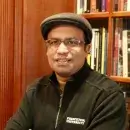
Professor
M. Zahid Hasan
Princeton University
Area
Mathematical and Physical Sciences
Specialty
Physics
Elected
2020
Eugene Higgins (endowed chair) Professor of Physics at Princeton University. PhD (Stanford University & SLAC, 2002). Robert H. Dicke Fellow at Princeton (2002). Visiting Miller Professor at UC Berkeley/Visiting Faculty Scientist at Lawrence Berkeley National Lab. Research Areas: Quantum Physics of Matter; Quantum Topology; Emergent Phenomena. Topological Quantum Science and Engineering. Current research focus: Developing advanced spectroscopic, transport, and microscopic techniques combined with first-principles theoretical calculations to design, discover, and investigate topological quantum matter. Novel phases of topological & strongly correlated quantum (many-body) matter and exotic superconductors. Hasan helped launch the field of Topological Insulators (2007 onward [1]) by directly detecting the predicted novel surface states and thoroughly demonstrating their unusual topological properties using advanced spin-sensitive spectroscopic techniques for the first time (50,000+ citations) and setting a new comprehensive experimental paradigm for it. Subsequently, he has theoretically and experimentally discovered many novel classes of topological matter and topological phase transitions, including Topological Magnets (via the demonstration of Chern gap in 2012), using novel instrumentations and innovative methods, and introduced designed discovery methods. The field expanded to include topological semimetals, notably Weyl Semimetals, whose states mimic massless fermions considered in quantum field theory. In 2015 Hasan observed the emergent Weyl fermions and novel topological Fermi arc surface states in several topological semimetals that he and his team theoretically predicted in arsenide and other materials. His Weyl fermion work is based on his and his team's theoretical predictions in several spin-orbit materials. Subsequently, he has theoretically and experimentally discovered many novel classes of magnetic topological semimetals. He has also made groundbreaking contributions (theoretical and experimental) in the subfields of topological phase transitions, topological magnets in 2D and 3D, topological nodal-line and drumhead metals, topological magnetic semimetals, topological chiral crystals, topological Hopf link semimetals, topological Hund nodal line antiferromagnet, Chirality and topology theory, Kagome chiral charge-order, Kagome nematic order, topological superconductors, Helicoid-arc quantum states and Kagome magnets and materials, Chern magnets and charge-ordered Kagome superconductors enabled by innovative applications and development of experimental methods. He identified room-temperature topological materials. A vast majority of his experimental discoveries are based on his and his team's theoretical predictions of topological materials. His research works have opened several new unexpected (unpredicted) fronts in topological kagome magnet and superconductor research. These topological materials are broadly important for future quantum device applications with higher energy efficiency for quantum technologies, as quantum information science platforms, and for exploring new emergent or many-body quantum physics [1]. He has also contributed to the conceptual design and theoretical development of some of these topics and written several comprehensive review articles by invitation. Hasan team demonstrated novel methods to measure topological invariants beyond Chern numbers without measuring transport of Hall transport. It is this new method of measuring topological invariants that led to a new experimental revolution in the field, which additionally uncovered many unpredicted and unexpected novel quantum phenomena not envisioned by theory. The methodologies introduced by him to explore and discover topological materials and phenomena are being used by others worldwide to further advance the field and have led to new discoveries [1]. His experiments and methods setting a new paradigm for the field have been seminal in giving rise to the field of "Topological Quantum Matter" with multiple discoveries with more than 100,000 citations (over 250 publications with H-factor 112+), which is now growing vigorously at the nexus of condensed matter physics, materials engineering, nano-science, device physics & quantum engineering, chemistry and relativistic quantum field theory as evidenced in all citation tracks. His results have extended our old textbook-level understanding of quantum matter and are now being featured in many standard textbooks of condensed matter physics used in universities worldwide. His research works have been featured in Physics Today, Physics World, Scientific American, Nature News, Science News, Discover magazine, New Scientist, and similar media multiple times over the decades. He is the Principal Investigator of the Laboratory for Topological Quantum Matter and Advanced Spectroscopy at Princeton University. Over the last decades, this lab has been active in generating novel ideas, methodologies, and instrumentations to create next-generation tools for quantum materials research and discovery. Hasan laid the experimental foundations for modern "Topological Quantum Matter". He has also led projects and held visiting positions at Bell Laboratories, UC Berkeley, Stanford University, SLAC, and the California Institute of Technology's IQIM (a National Science Foundation Physics Frontiers Center), as well as at MIT.
[1] For additional detail: "Proceedings of the National Academy of Sciences"
https://www.pnas.org/doi/10.1073/pnas.1611504113
Last Updated